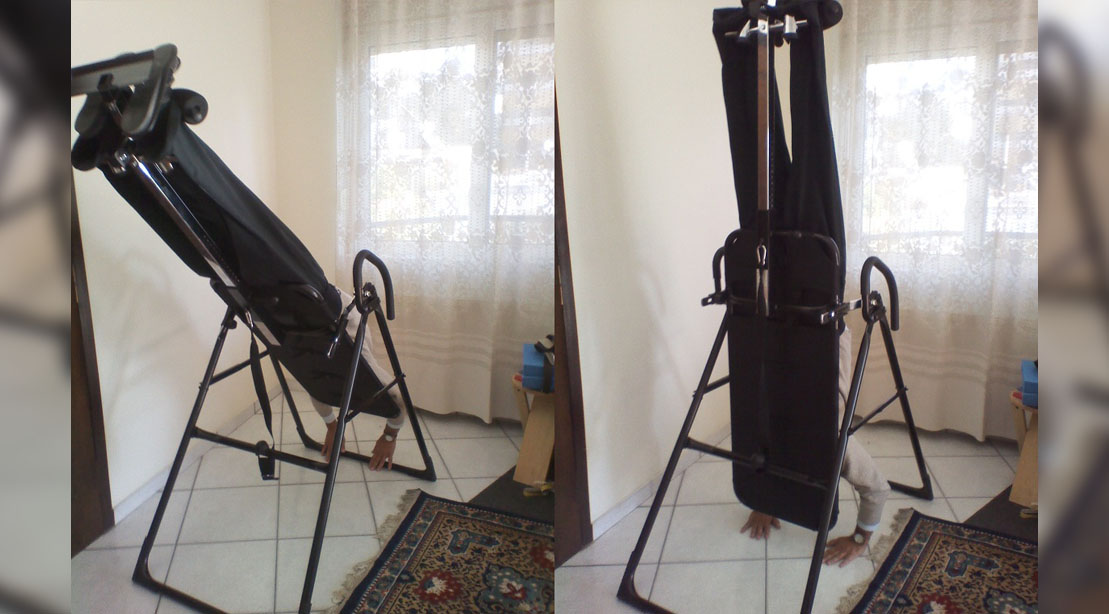Back pain is the leading cause of work limitations globally; and if you’re a heavy lifter, lack proper posture, or experience regular stress, you may be one of the 50 to 80 percent of adults who will experience at least one episode of back pain in their lifetime.
With these eye-opening statistics, what if simply strapping yourself onto a cushioned table and tipping partially upside down could help relieve your dreadful back pain and keep you from missing your workouts?
Seem too good to be true? Maybe not.
“Inversion tables are beneficial for relieving back and hip pain from issues such as poor posture, arthritis, and degenerative disc disease,” explains Dr. Michael Recupero who has provided chiropractic care and functional therapy to his patients since 2000, and shares that many people have seen benefits from sciatica symptoms and other radiating nerve symptoms in the legs by using an inversion table.
“Decompression (via an inversion table) has also been used to increase circulation, stretch muscles, increase flexibility, and lymphatic drainage, and optimize lung capacity, and has been studied for years for its health benefits for a multitude of issues.”
So, what exactly is an inversion table? Simply put, an inversion table is a device that straps the user’s ankles in place so the head and upper body can be safely inverted lower than the feet. “This is done to alleviate the stress of gravity and compression on the spine and hips that occur during everyday life, explains Dr. Recupero.
While these benefits are reason enough to want to place an order for an inversion table ASAP, there are important factors that need to be taken into consideration before going upside down.
How to Buy an Inversion Table
If you’ve ever researched inversion table(s) you’ll see there are many different brands and styles to choose from. Although you may want to make a quick purchase, it’s important to become well-acquainted with the equipment before using it. Talking to a qualified Doctor, such as a chiropractor, will help you make the best decision for your health plan.
Doctor Approved Guide On How To Use An Inversion Table
Important Safety Tip: Make sure you are not alone when using the table in case you need assistance for any reason.
- Be sure to strap your ankles properly and securely in place before lying back.
- Start by lying horizontally on the table for a few minutes before starting.
- Practice a sequence of gradual decline so that the muscles, joints, and soft tissue acclimate to the decompressive force.
- Start by declining the table about 15 degrees for 30-60 seconds, and then return to horizontal “neutral” for the same amount of time.
- Next decline approximately 30 degrees for the same amount of time and again return to neutral.
- Depending on your level of comfort, this process of decompression and rest can be repeated at 45 degrees and finally at 60 degrees. This process allows the body to gain the physiological benefits of the therapy without over-stressing the body.
Good to Know: Dr. Recupero does not have people fully invert or remain in a declined position for any longer than one to two minutes.
Who Shouldn’t Use an Inversion Table?
Although the inversion table comes with many benefits, it’s not for everyone. Dr. Recupero shares the risk factors that may contraindicate the use of inversion therapy which include:
- Cardiovascular disease
- High blood pressure
- Glaucoma (or other eye diseases)
- Pregnancy
“If there is a history of disc injury, nerve symptoms in the legs, or joint instability in the hips, knees, or ankles you should consult a health care practitioner before using an inversion table,” shares Dr. Recupero.
Keep in Mind: Don’t fret if you fall under any of these categories while suffering from back pain. Paying a visit to a qualified doctor will help you get on a plan to relieve your back in ways that best serve your body and individual situation.
Final thoughts: Inversion tables are a valuable tool (when used properly) to de-stress the pressures of daily posture and gravity on the spine and muscles and are an excellent at-home adjunct therapy for a variety of musculoskeletal conditions. (Even arthritis)
Don’t let back pain stop you from breaking PRs or from performing your favorite exercises!
